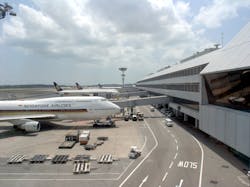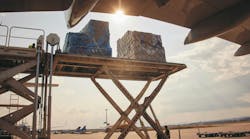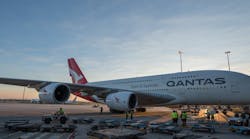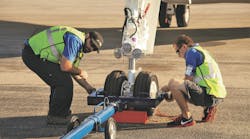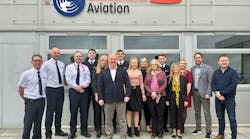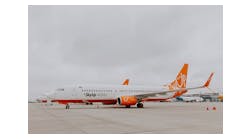Barely two months into his job as CEO of dnata's Singapore operations, Mark Edwards is feeling the heat. The 55-year-old has the unenviable task of managing 53 airline customers and some 1,750 staff members at a time when global demand for air travel and freight services is slowing and operating costs are escalating.
Having been in the industry for more than three decades, Edwards is no stranger to the business of providing ground-handling, cargo and catering services to airlines and airports. Yet, he concedes that the task at hand remains arduous. Since starting work at dnata, he has been touching base with customers and staff to ensure things are in order. dnata's clients in Singapore include Cathay Pacific Airways, Malaysia Airlines, Lufthansa, Emirates and Delta Air Lines.
"Things are tough," Edwards tells The Edge Singapore. "The operating environment is still difficult."
He took the helm at dnata Singapore in June, when Georgie Ong retired after more than three decades with the company. Edwards was previously senior vice president at US-based Aircraft Service International Group (ASIG), responsible for its global business development.
"New challenges, new opportunities," Edwards says, explaining his move from ASIG to dnata. "The business being part of a well-respected global organisation appealed to me." Dubai-headquartered dnata operates in 39 countries and 74 airports worldwide. It serves 53 airlines in Singapore. ASIG, on the other hand, targets mainly airlines and airports in the U.S. and Europe. Its presence in Asia is limited, with operations only in Bangkok.
Singapore would have been ASIG's second operating base in Asia after it secured a 10-year ground-handling licence at Changi Airport last June, paving the way for it to become the airport's third ground handler after SATS and dnata. However, it has yet to commence operations.
"It's our policy not to comment on what our competitors are doing or not doing. I can only confirm what you already know. All the ground handlers at Changi face challenges with reduced margins," Edwards says.
Any casual observer at the airport might think otherwise, though. Indeed, business generally remains buoyant at Changi, where an aircraft takes off or lands roughly every 100 seconds. Some 100 carriers operate at the airport. According to its latest available data, the number of passengers handled at Changi increased 11.6 percent y-o-y in 1H2012 to 25 million.
A government-appointed committee is even drawing up ambitious plans to boost Changi's capacity and help it retain its position as one of the world' s leading aviation hubs. Some 1,000ha of land have been earmarked for the expansion of the airport, which now occupies an area spanning 1,350ha. The committee is also deciding when to open a third runway and whether to build more terminals at Changi.
Plans are already afoot to further upgrade Terminal 1, where a $500 million exercise to expand its floor space was completed in July. Changi's budget terminal will also be torn down to make way for Terminal 4, which is slated to open in 2017. The airport will be able to accommodate 85 million passengers a year once the new facilities are ready. It handled more than 46 million passengers in 2011.
All this should spell good news for ground handlers, but those in the business, including Edwards, remain guarded as Europe's debt crisis continues to weigh on business confidence and travel demand worldwide. While passenger volumes at Changi are holding up so far, cargo movements have been less than encouraging. Cargo throughput at the airport declined 1 percent y-o-y in first half of 2012 as airfreight demand weakened.
Indeed, for the quarter ended June, SATS, which has the lion's share of the ground handling and cargo businesses at Changi, reported a 5.2 percent y-o-y fall in cargo throughput. The performance bucked improvements in the rest of its operations.
"There are certain expectations by industry players that there will be some form of a turnaround or bottoming in the second half of this year [for the cargo business]," says SATS' chief financial officer Lim Chuang. "I have to say at this point in time that there is still no clear sign of a bottoming or turnaround."
According to the International Air Transport Association's latest data, global airfreight traffic in May slipped 1.9 percent y-o-y. "Over the past six to nine months, the market [for airfreight] has been flat at best," IATA says in its most recent monthly market analysis.
Higher costs, other risks
Rising costs are another major source of concern for both dnata and SATS.
"We, like other companies, are facing significant cost pressures," says Edwards. "We continue to experience yield pressure from our airline customers and cost pressures due to the economic environment."
For SATS, its total expenditure in the quarter ended June increased 12.6 percent y-o-y to almost $400 million, growing at an almost similar pace as its revenue, which rose 13.6 percent to $438 million. Staff costs, which increased 13.4 percent, accounted for almost half of SATS' total expenses, followed by costs of raw materials for its food catering business.
Cost pressures are likely to persist in the near term as Singapore tightens the inflow of foreigners following complaints from citizens about overcrowding and competition for jobs, housing and places for their children in schools.
"Tight quotas on the recruitment of foreign labour has, of course, made it harder to recruit," Edwards concedes.
The situation at SATS is no different, although Lim says the ground handler still has a sufficient headroom for the foreseeable future before it reaches its quota for foreign staff.
"Some of the increases in staff costs have come from this tightening, but it is something we are actively trying to manage," says Lim. Efforts by SATS to contain costs include converting fixed expenses into variable costs, and streamlining its food solutions business, he adds.
The growing clout of other major airports is also becoming a risk. Qantas Airways, which is struggling to turn around its international business, is in talks with Emirates to form an alliance that could lead to its flights from Australia to Europe being diverted through Dubai, effectively bypassing Singapore. Qantas is a customer of SATS' at Changi.
The confluence of these various challenges is perhaps why ASIG has not started ground-handling work at Changi, despite having secured regulatory approval more than a year ago to do so. The 2009 exit of Swissport, which chalked up losses of more than $50 million four years after it opened for business in Singapore, probably still serves as a warning that even Changi, with its string of accolades earned over the years for its global connectivity and service standards, may not have room for another ground operator.
For now, the two operators point out that their airline customers are sticking to their existing service contracts.
"As far as we are concerned, we managed to renew whatever contracts that were due during the [June] quarter and there was no loss on our part whatsoever, says Lim. According to Edwards, business is still intact for dnata, although "we are well aware that customers always have a choice" to switch to another ground handler.
Staying relevant
As part of its efforts to stay relevant, dnata opened a new passenger lounge at Changi in July. Located in Terminal 3, the $1 million lounge for premium passengers is the company's second such facility at Changi. New uniforms for service and operations staff have also been introduced, following the recent completion of the entire dnata group's global rebranding exercise, which brought all its entities worldwide under a single brand. Its Singapore business was previously known as Changi International Airport Services, which the dnata group acquired in 2004 from Temasek Holdings for $180 million.
dnata is not stopping there.
"This year, I can confirm we will make a record investment at Changi. This will include investment in equipment such as those for ground support and in improvements to our cargo facility," Edwards says.
For SATS, the tougher operating environment has prompted it to diversify into new businesses. It set up a subsidiary last month to provide catering, housekeeping and related services in Australia.
In May, it welcomed its first cruise ship at the Marina Bay Cruise Centre, which it jointly runs with a European cruise terminal operator under a 10-year contract. An initiative of the Singapore Tourism Board, the 28,000 sq m cruise terminal at Marina South can accommodate some of the world's largest cruise ships. SATS also has a joint venture to supply food to companies operating in remote areas worldwide. The business will initially target industries such as oil and gas, mining, marine, defence and infrastructure construction.
Contributions from its new businesses won't be immediate, though.
"It will take three to four years before we see meaningful revenue from the cruise operations," says Lim. "The remote catering business is a little bit harder to predict because that is contingent on how fast we get the contracts. We will not get enough contracts this year to make a profit."
With the increased challenges facing ground handlers, analysts have generally held back from issuing bullish calls on SATS.
Of the 14 analysts tracking the company, more than a third have a hold or a neutral call for the stock, with the remaining recommendations almost evenly divided between buy and sell. The median price target for SATS is $2.65, about 3 percent higher than the stock's recent price, which has been supported by the prospect of another special dividend. In its last financial year ended March, SATS declared a total payout of 26 cents a share, including a special dividend of 15 cents a share. That translates into a 10 percent yield, based on its current share price.
While acknowledging that the stakes are higher this time around for the general aviation industry, Edwards is placing his bet on Changi's established track record even as he continues to keep an ear to the ground to make sure business is in order.
"dnata's business has grown in line with that of Changi Airport's, and we expect that to continue," Edwards says.
Copyright 2012 The Edge Publishing PTE. LTD.All Rights Reserved
